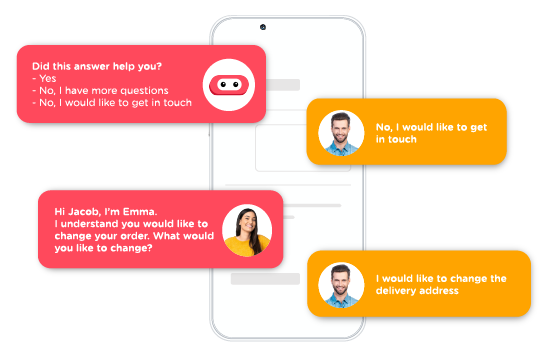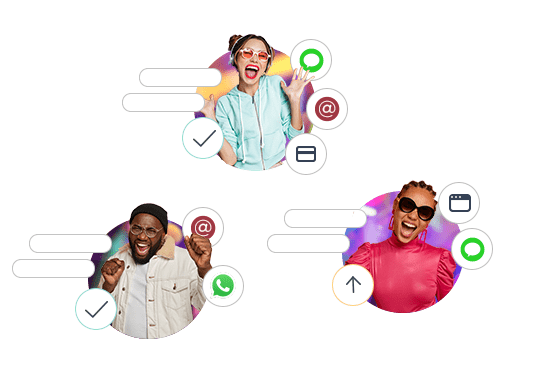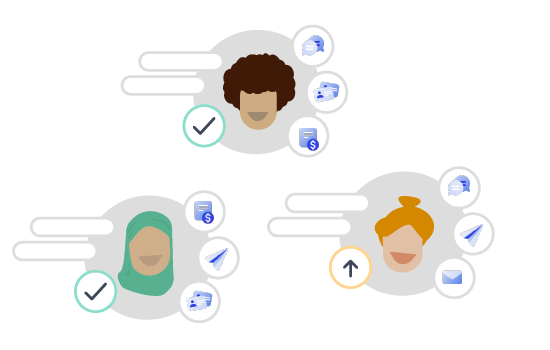- How Does a Helpdesk System Work?
- Scaling up With a Next-generation Conversational Helpdesk System
- Solve Queries Faster Through All Possible Permutations the Resolution Might Take
- Achieving Proactive Customer Service Using a Conversational Helpdesk Solution
In today’s service-led, experience-driven engagement model, customer service and support have become the key pillars of customer satisfaction. Consumers are using various communication channels and chat apps to engage with a brand and get their questions answered. Customers may want to contact you throughout the customer journey for all kinds of questions, and these are no longer restricted to post-purchase alone. It is an integral function across the customer journey.
For instance,
- Inquire/ask about a product or a service
- Make a purchase/schedule an appointment
- Get product or service support/comment or review about a product
- To request general and specific questions throughout the customer journey
But, to offer excellent service (with technological limitations brought by legacy platforms) meant that we, as business leaders, faced a tough choice as our companies, customers, conversations, and teams grew.
With increasing conversation volumes and rising expectations of customers, how do the customer service teams manage to give good service (forget great here)? With the rising volume of conversations, how do you meet the customer demands? Achieving customer-centric and proactive customer service is key.
That’s where the importance of the conversational helpdesk system comes into play. You can use it to build a robust customer service that meets your customers’ need for a speedy resolution and eliminate queues.
But it can be challenging to understand what conversational helpdesk entails, which leads to this article.
In the last article, we covered helpdesk ticketing systems and what it means for businesses. In this article, we will delve deeper into the conversational helpdesk system and its features.
How Does a Helpdesk System Work?
Traditionally, when customers face an issue or a complaint, they contact the help desk. The service agent at the help desk then works on a series of events to confirm a ticket regarding the issue. The ticket moves or gets assigned to an appropriate team, and then the problem is either resolved or moved ahead to another authority, as the case may be.
But there are challenges.
All these actions may take days or weeks to get completed before the customer gets closer to getting his issue resolved. It’s common for a customer to be frustrated because he is not informed of the status of his complaint or when it shall be resolved. The customer service reps are also frustrated as they must perform the same set of daily tasks, most often leading to inefficient time management and productivity challenges.
With an increasing number of conversations and fewer resources, it gets challenging for agents to keep pace with the demands of the business, especially without a modern tool built for scale and speed.
Luckily, there is a solution!
Scaling up With a Next-generation Conversational Helpdesk System
As customer service organizations launch new channels to engage their customers and increase their digital footprint, it is natural to see a surge in customer queries that expect rapid and personal resolution.
Now think of your service reps who are constantly drowned in the massive pile of questions trying to resolve these queries, some of which can be highly repetitive. Is it any wonder your team continually seems on the edge of burnout? Stepping into a more proactive customer service can be a game-changer.
The conversational helpdesk system works on a conversation-first model against a conventional ticketing system where customers are treated as mere tickets. Keeping your customer service centered on customer conversations is the most effective, efficient way to provide personalized service at the scale of your business needs as it grows.
Solve Queries Faster Through All Possible Permutations the Resolution Might Take
To manage every customer conversation with efficiency and empathy, your customer service teams need a helpdesk solution that combines the right elements of speed and intuitiveness - a conversation manager that works efficiently for every channel your customer chooses to communicate.
A smart helpdesk solution provides faster resolution to customer queries and offers to handle complex issues that are hard for bots alone to handle. It becomes easier to quickly resolve complex issues by getting them to the right team member on time.

The outcomes of better utilization of human resources available to the business and timely customer complaints cannot be underrated. Also, how can you ignore employee and customer satisfaction and the gains it can fetch you in terms of cost savings. This emphasizes why service organizations need to emphasize customer engagement tools like intelligent helpdesk systems to offer an excellent customer service experience.
Achieving Proactive Customer Service Using a Conversational Helpdesk Solution
The Conversational Helpdesk is designed to flex and adapt to your businesses’ needs and its agents. Let’s jump in and see how each element of the Conversational Helpdesk has a role to play in liberating your customer service team. Let’s explore some top ideas on how to achieve proactive customer service using the Conversational Helpdesk System.
#1 It All Starts With an Omnichannel Core
Traditional ticketing systems were created in the days when e-mail was the primary communication channel. But, delivering satisfaction has always been a challenge via e-mail because it’s hard or impossible to solve the customer’s issue in a single interaction - which kills the purpose of delivering a good customer service experience.
Having an omnichannel core and availability on chatbots, live chat, and popular messaging channels facilitate an honest conversation with customers: a dialogue throughout all stages of the customer journey.

For brands, omnichannel presence has become a #1 aspect and a first step in providing excellent customer experiences. Irrespective of the platform a customer uses to engage with a brand, an omnichannel presence ensures seamless two-way communication between the customer and the brand.
This is a massive opportunity to finally deliver faster and more personalized customer service experiences that reduce effort and increase chances of customer retention and loyalty.
The conversational helpdesk system helps the service staff find and address customer queries without the hassles of switching to multiple channels. This is why we chose to build a channel-agnostic solution; all channels work the same, and all core features work for all channels, including modern channels such as live chat and messaging.
#2 Team Productivity and Collaboration Matters
As highlighted in the last article, a good helpdesk solution makes the service teams’ operations faster and more efficient when it’s based on the core concept of ownership. Here, every customer question is owned by an agent, not leaving any conversation unattended. We have imbibed this by offering various advanced routing principles that make sure every conversation is routed to the right agent and owned by that particular agent - also considering capacity and elimination of queues.
So, individual agents can manage their omnichannel inbox, which can be a mix of different channels. This direct ownership of the conversations allows them to act within the SLA (response time). This, so far, has resulted in faster resolution time within the SLA, ensuring our clients and their customers get to the desired resolution without unnecessary delay.

Though a conversation can only be owned by one agent, great customer service is not one man’s job. You need your teammates to give you quick insights that are relevant to the conversation.
A conversational helpdesk solution, therefore, should be an open collaboration system:
- Built to break the siloed conversations
- Allowing teams to collaborate efficiently in real-time and right next to the customer conversation.
- Help your team ramp up the response and resolution time with a customer-centricity focus instead of ticket focus.
This approach aims to solve queries through all the possible permutations the resolution might take via faster collaboration with team members.
Giving individual agents their personal inbox and a team inbox with an intuitive dashboard makes it easier for teammates or supervisors to view, take over, or forward conversations to others.
Mobile Service Cloud at CM.com is designed to sync and offer customer conversations, internal communication, external communication, and customer panel all in one screen to ensure no conversation is siloed.
This intuitiveness of design and flexibility allows agents to stay on top of the service requests and ensure they meet customer expectations in every conversation.
#3 Have a Single Source of Truth With Contextual Data
In a fast-paced environment, service agents don’t have the time to look up all the data distributed across various systems while staying focused on the conversation.
How about getting instant insights about the customer in one view with a 360° customer profile. A single profile linking all customer’s data offers agents relevant contextual information to engage with the customer and gives them instant insights next to the conversation. All this happens regardless of the channel – all customer information is available to agents on one screen.

You can integrate data with your e-commerce system, CRM, ERP wherever you have your customer’s data stored. You can now view a customer’s name, number, e-mail, orders, history, the status of delivery all conversations from all channels gathered under one customer profile.
With Mobile Service Cloud, you can integrate your CRM and e-commerce platforms, and the data integration works seamlessly across all channels.
This gives great context for all the conversations with customers without even leaving the conversation.
‘Contextual data’ is one of the most prominent features and design principles of Mobile Service Cloud.
Conclusion
Suppose your customer service promise is to deliver a great customer experience. In that case, your bottom line is not just a customer service software that predominantly works on e-mail but a conversation manager that works efficiently for every channel your customer chooses to communicate.
To manage every customer conversation with efficiency and empathy, your customer service teams need an agent workspace that combines the right elements of speed and intuitiveness.
At CM.com, we have combined these elements within the core design principle of our customer service solution, which comes with a highly intuitive dashboard plus a personal inbox. This gives your agents direct ownership of each conversation to drive it with context.
The solution aims to generate a great customer experience – making conversations via any channel fast and frictionless. To sum up, our main message here is customer centricity at all costs!
Using a modern customer service solution, like Mobile Service Cloud by CM.com, you can have:
- Conversations across multiple channels in one place without compromising on efficiency.
- A future-proof way to scale your customer service and deliver delightful customer experience.
- Personalized and contextual conversations with customers across channels in a way that feels far simpler and more convenient than the channels of the past.
Empower your customer service to respond to the customers’ need for real-time and personal contact with businesses. Automate and personalize all customer interactions through their favorite mobile channels.
If you wish to learn how to scale your customer service and delight your customers, we are here to help. Please request a call back from our team to get started.
